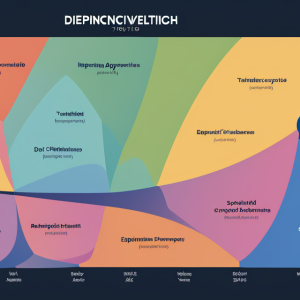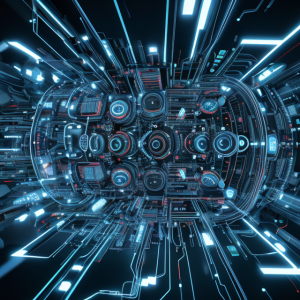Deep learning is a subfield of machine learning that has revolutionized the field of artificial intelligence in recent years. It involves the use of artificial neural networks to model and solve complex problems. With its ability to learn and make predictions based on large amounts of data, deep learning has become an essential tool in many industries, from healthcare to finance. In this article, we will explore the importance of deep learning in the field of artificial intelligence and why it is necessary for advancing the development of intelligent systems. We will also discuss some of the challenges and limitations of deep learning and how they can be overcome.
Enhancing Pattern Recognition and Analysis
Deep learning as a powerful tool for pattern recognition
Deep learning has emerged as a game-changer in the field of artificial intelligence (AI) by providing a powerful tool for pattern recognition. Traditional machine learning algorithms rely on hand-crafted features, which can be both time-consuming and error-prone. In contrast, deep learning enables the learning of hierarchical representations of data, which allows for the extraction of high-level features that are both robust and discriminative.
The ability of deep neural networks to extract high-level features
One of the key advantages of deep learning is its ability to automatically learn hierarchical representations of data. This means that deep neural networks can learn to identify complex patterns in data, such as objects within images or speech segments within audio. These high-level features are abstract and generalizable, which makes them highly useful for a wide range of applications.
Applications of deep learning in image and speech recognition
Deep learning has revolutionized the field of image and speech recognition. In image recognition, deep neural networks can be trained to identify objects within images, such as faces, cars, or animals. This has numerous applications, including security systems, autonomous vehicles, and medical image analysis. In speech recognition, deep neural networks can be trained to transcribe speech from audio recordings, which has numerous applications in natural language processing and virtual assistants.
Overall, deep learning has become an essential tool for pattern recognition and analysis in AI. Its ability to automatically learn hierarchical representations of data has enabled it to achieve state-of-the-art performance in a wide range of applications, from image and speech recognition to natural language processing and robotics.
Handling Big Data
The exponential growth of data in today's digital age has led to a need for more efficient and effective methods of processing and analyzing this data. Traditional methods of data analysis have limitations when it comes to handling large datasets, making deep learning algorithms a necessary tool in the field of artificial intelligence.
Exponential Growth of Data
With the proliferation of digital devices and the increasing amount of data generated by these devices, the amount of data available to be analyzed has grown exponentially. This has created a need for new and more efficient methods of data analysis, as traditional methods can quickly become overwhelmed by the sheer volume of data.
Challenges of Processing and Analyzing Big Data
Processing and analyzing big data can be a daunting task, especially when using traditional methods. One of the main challenges is the sheer size of the data, which can make it difficult to process and analyze in a timely manner. Additionally, traditional methods may not be able to identify patterns or trends in the data, making it difficult to extract meaningful insights.
How Deep Learning Algorithms Handle Big Data
Deep learning algorithms are designed to handle large datasets efficiently, making them an ideal tool for processing and analyzing big data. These algorithms are able to process and analyze large amounts of data quickly and efficiently, allowing for more accurate and timely insights. Additionally, deep learning algorithms are able to identify patterns and trends in the data, making it easier to extract meaningful insights. This makes them a crucial tool in the field of artificial intelligence, as they allow for more efficient and effective processing and analysis of big data.
Improving Decision-Making and Predictive Capabilities
Deep learning's ability to make accurate predictions and informed decisions
Deep learning has emerged as a game-changer in the field of artificial intelligence, thanks to its ability to analyze vast amounts of data and identify patterns that would otherwise go unnoticed. By harnessing the power of neural networks, deep learning models can learn from vast amounts of data and make predictions with a high degree of accuracy.
Use cases of deep learning in forecasting, financial analysis, and healthcare
Deep learning has a wide range of applications in various industries. In forecasting, deep learning models can analyze historical data to predict future trends, which can be useful in fields such as weather forecasting, stock market analysis, and energy management. In financial analysis, deep learning can be used to detect fraudulent transactions, assess credit risk, and identify investment opportunities. In healthcare, deep learning can be used to analyze medical images, predict patient outcomes, and develop personalized treatment plans.
The role of deep learning in optimizing business processes and strategies
Deep learning has the potential to revolutionize the way businesses operate. By analyzing data from various sources, deep learning models can help businesses identify inefficiencies, optimize processes, and develop strategies for growth. For example, deep learning can be used to analyze customer behavior and preferences, which can help businesses improve their marketing efforts and increase customer satisfaction. In addition, deep learning can be used to analyze supply chain data, which can help businesses identify bottlenecks and optimize inventory management.
Overall, deep learning's ability to make accurate predictions and informed decisions has far-reaching implications for various industries. By leveraging the power of neural networks, deep learning models can help businesses make better decisions, optimize processes, and stay ahead of the competition.
Advancing Natural Language Processing
Understanding and processing human language is a complex task, and deep learning techniques have proven to be essential in achieving significant breakthroughs in natural language processing (NLP). NLP is a subfield of artificial intelligence (AI) that focuses on the interaction between computers and humans using natural language. Deep learning has significantly advanced NLP by enabling machines to understand, interpret, and generate human language with greater accuracy and efficiency.
One of the key challenges in NLP is language modeling, which involves predicting the probability of a sequence of words in a given language. Deep learning techniques, such as recurrent neural networks (RNNs) and long short-term memory (LSTM) networks, have shown remarkable success in language modeling tasks, such as machine translation and text generation. These techniques use hidden layers to capture the context and dependencies between words, enabling machines to generate coherent and fluent text that closely resembles human language.
Another important application of deep learning in NLP is sentiment analysis, which involves determining the sentiment or emotion behind a piece of text. Sentiment analysis is critical in various industries, such as marketing, customer service, and social media monitoring. Deep learning techniques, such as convolutional neural networks (CNNs) and word embeddings, have significantly improved the accuracy of sentiment analysis, enabling machines to understand the nuances and complexities of human emotions.
In addition to language modeling and sentiment analysis, deep learning has also been applied in other NLP tasks, such as speech recognition, text classification, and question answering. For instance, deep learning techniques have been used to develop chatbots and virtual assistants that can understand and respond to natural language queries from users. Similarly, deep learning has enabled machines to perform machine translation, allowing them to translate text from one language to another with high accuracy.
Overall, deep learning has played a pivotal role in advancing natural language processing, enabling machines to understand and process human language with greater accuracy and efficiency. As the field of AI continues to evolve, deep learning is expected to remain a critical component in driving further advancements in NLP and other areas of AI.
Enabling Autonomous Systems and Robotics
Deep learning's role in enabling self-driving cars and autonomous robots
Deep learning has become a vital component in the development of autonomous systems, particularly in the field of robotics. The use of deep learning algorithms allows robots to interpret sensory inputs, enabling them to make real-time decisions and execute tasks without human intervention. One of the most notable applications of deep learning in robotics is in the development of self-driving cars. These algorithms can process vast amounts of data from cameras, radar, and other sensors to interpret the environment and make decisions about steering, braking, and acceleration.
How deep learning algorithms learn from sensory inputs and make real-time decisions
Deep learning algorithms rely on artificial neural networks to learn from sensory inputs and make decisions. These networks are composed of layers of interconnected nodes that process information and learn from examples. Through a process called backpropagation, the network adjusts the weights and biases of the connections between nodes to minimize errors and improve performance. This process allows the network to learn complex patterns and relationships in the data, enabling it to make accurate predictions and decisions based on sensory inputs.
The future potential of deep learning in revolutionizing various industries
The potential applications of deep learning in robotics and autonomous systems are vast and varied. Self-driving cars and trucks could revolutionize transportation, reducing accidents and increasing efficiency. Autonomous robots could be used in manufacturing, healthcare, and other industries to perform dangerous or repetitive tasks, freeing up human workers for more complex and creative tasks. Additionally, deep learning algorithms could be used to improve the efficiency of renewable energy systems, such as wind and solar power, by optimizing the placement and operation of these systems.
Overall, deep learning has the potential to revolutionize various industries by enabling the development of autonomous systems that can learn from sensory inputs and make real-time decisions. As these technologies continue to evolve and improve, we can expect to see more widespread adoption of autonomous systems in a variety of fields.
Addressing Limitations and Challenges
As deep learning continues to revolutionize the field of artificial intelligence, it is important to address the limitations and challenges associated with this technology.
Ethical considerations and concerns regarding deep learning
One of the primary concerns surrounding deep learning is its potential impact on privacy and ethics. With the ability to analyze vast amounts of data, deep learning models can potentially be used to invade individuals' privacy and make decisions that may have significant ethical implications. Therefore, it is essential to ensure that deep learning models are designed and used in a responsible and ethical manner.
The need for interpretability and transparency in deep learning models
Another challenge associated with deep learning is the lack of interpretability and transparency in these models. As deep learning models become more complex, it becomes increasingly difficult to understand how they arrive at their decisions. This lack of transparency can lead to unethical or biased decision-making, making it essential to develop techniques that allow for greater interpretability and transparency in deep learning models.
Continuing research and development to overcome limitations and improve deep learning techniques
To address these challenges, ongoing research and development are necessary to improve deep learning techniques and overcome limitations. This includes developing new algorithms and architectures that can improve the interpretability and transparency of deep learning models, as well as addressing ethical concerns by ensuring that these models are used in a responsible and ethical manner. Additionally, continued research into the impact of deep learning on privacy and ethics is necessary to ensure that these models are designed and used in a way that respects individuals' rights and protects their privacy.
FAQs
1. What is deep learning?
Deep learning is a subset of machine learning that uses artificial neural networks to model and solve complex problems. It involves training deep neural networks with large datasets to learn patterns and features in the data, which can then be used to make predictions or decisions.
2. Why is deep learning necessary?
Deep learning is necessary because it allows us to build models that can automatically learn and extract features from large and complex datasets. This is particularly important in the field of artificial intelligence, where we often have to deal with vast amounts of data and complex problems. Deep learning enables us to build models that can automatically learn from this data and make predictions or decisions based on it.
3. What are some applications of deep learning?
Deep learning has numerous applications in various fields, including computer vision, natural language processing, speech recognition, and robotics. In computer vision, deep learning is used to build models that can recognize objects in images and videos. In natural language processing, deep learning is used to build models that can understand and generate human language. In speech recognition, deep learning is used to build models that can recognize and transcribe speech. In robotics, deep learning is used to build models that can learn and improve their performance over time.
4. What are the advantages of deep learning?
The advantages of deep learning include its ability to automatically learn from large and complex datasets, its ability to achieve state-of-the-art performance on many tasks, and its ability to generalize well to new data. Deep learning models can also be trained using unsupervised learning techniques, which allows them to learn from data without the need for explicit labels. Additionally, deep learning models can be easily scaled up to handle large datasets and can be used to build complex systems that can learn and adapt over time.
5. What are the limitations of deep learning?
The limitations of deep learning include its reliance on large amounts of data, its need for specialized hardware and software, and its susceptibility to overfitting. Deep learning models also require a significant amount of computational resources and can be difficult to interpret and understand. Additionally, deep learning models may not always generalize well to new data or be able to handle small or imbalanced datasets.





